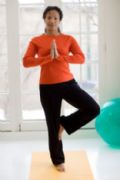Hiking on a wooded trail. Riding a bike down the street. Doing crunches on a stability ball. Hitting the slopes. Walking up the stairs with ease. These are more than simple pleasures you can enjoy by living a healthy lifestyle. They're also proof that your body's ability to balance while doing a variety of things is pretty amazing. Even when you're not thinking about it, your body is balancing—in everyday life, when you exercise, and during your active pastimes.
Most people don't spend any time thinking about their balance until it's too late—when they actually fall or injure themselves. But balance isn't just a concern for the elderly who are more prone to falls (and the serious complications those falls can cause). Balance training is important for everyone, from athletes to casual exercisers.
Good balance and a strong core go hand in hand, and a strong core usually means better posture, less back pain and improved performance during exercise and athletics. Plus, the better you balance the less likely you are to fall or injure yourself. If you haven't thought much about maintaining—or enhancing—your balance, now is as good a time as any to start.
You've probably seen lots of fancy fitness gizmos that are designed to help you improve your balance—everything from a simple stability ball to balance boards, inflatable balance discs, BOSU trainers, foam rollers and more. While these items certainly add challenge to your workout, you really don't need ANY fancy equipment—not even a WiiFit—to improve your balance. In fact, you can turn just about any standard strength-training or flexibility exercise into one that does double duty by improving your balance while you work your muscles. With multi-tasking moves like these under your belt, that means you won't have to spend more time exercising just to improve your balance. Find out how!
- Change Your Base of Support. Balance is your ability to maintain your center of gravity over your base of support. When you're standing up, your legs are your base of support. The wider your legs are, the wider your base is and the easier it is to balance. The closer your legs are together, the narrower your base of support is and the harder it is to remain balanced. One of the easiest ways you can challenge (and therefore help improve) your balance during any standing exercise is to gradually narrow your base of support until your feet and legs are together while you perform your exercise. Bring your legs closer together while you do standing biceps curls, shoulder raises, squats or other upper-body moves. Be sure to keep your abdominals pulled in tight and make sure you're not leaning backward as you perform your exercises. Note: You can also widen or narrow your base of support while lying on or sitting on a stability ball to perform exercises, so try this progression when you're on the ball, too!
- Try It on One Leg. Once you've mastered doing an exercise with a narrow base of support, you're ready for the next challenge: balancing on a single leg. Instead of standing on both legs during some of the same moves above, try it on a single leg. Start by just lifting one heel (keeping your toes on the floor) while doing your upper-body moves or working up to a single-leg squat. As you get better, lift that foot off the ground completely. From there, you can play around with the position of your lifted leg—holding it behind you, in front of you, to the side or, for a greater challenge, moving that leg while you balance on the other leg and perform upper body movements. Just be sure to alternate legs to keep your strength and muscle tone balanced (no pun intended) between both sides of your body. Tip: You can also experiment with momentary one-leg balances. For example, on a forward lunge, lift your front or back leg for a moment each time you push up out of your lunge.
- Close your eyes. Your sense of vision is a big part of the balance equation. It works hand in hand with the vestibular (inner ear) and proprioceptive systems to maintain balance and prevent falls. By staring at a single focal point (minimizing your head and eye movement), you'll balance more easily. If you move your gaze or take vision out of the equation altogether, it's harder to balance. This option is definitely a challenge—not something for beginners and not something you can do in any given situation. You'll want to make sure you're in a controlled environment and that your body is planted (don't attempt this while walking or hiking or moving through space). You can start by just standing up tall and closing your eyes without moving. Over time, combine the narrow base of support with some one-leg balances while closing your eyes. You might be surprised how challenging it is to simply stand with your eyes closed, let alone stand on one foot or while doing a biceps curl. Just be sure to use your best judgment and listen to your body when trying this technique. Safety first!
Now you know how to make balance training a forethought instead of an afterthought in your workouts—without spending more time or money on exercise. By using these techniques and really paying attention to your body as you exercise, you should notice improvements in your balance, coordination, posture, core strength and agility—ones that you can carry with you as you age, help you prevent spills and falls, and build your confidence when trying new and exciting fitness pursuits!
|







